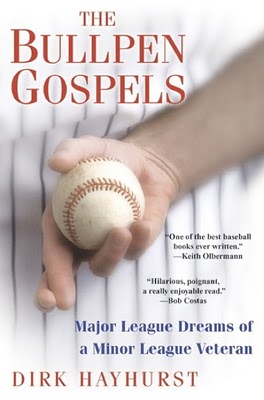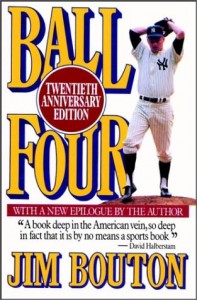My Top 10 Essential Sports Books
My friend Justin asked me to write a blog post of my top 10 essential sports books, and, well, who am I to deny my faithful readers?
Justin didn’t give me much of an outline beyond the fact that they should be non-fiction and that they’re books that would be essential for starting anyone looking to start a personal sports library.
I decided to interpret “essential” as a book that is timeless, has a broad scope that makes it accessible and, of course, features strong writing.
Variety was also a watchword when I put this together. When it comes to writing not all sports are created equal – coming up with a list of 10 baseball books is a snap, while naming even five essential hockey books can be tricky.
However, I did manage to get a decent spread of sports. Baseball, hockey, soccer, football, professional wrestling and other combat sports are all well represented.
I should also add that this list is designed to be taken as a whole. Many of these books are meant to dovetail with each other, provide contrast or compliment other entries.
They don’t need to be read in any particular order and none of them stand out as the best of the lot. But taken altogether all ten fit together nicely, giving the reader a reasonably broad understanding of sports and athletics, even if some specific sports are left out.
Of course, I’ll also point out that I’ve read all of these books (titles that have a link will take you to my earlier, full reviews of the book). Since I haven’t read every sports book ever there are, I’m sure, some gaps in my selections.
Now, in no particular order of preference:
The grand daddy of ‘em all, Ball Four is Jim Bouton’s memoir of a year as a major league pitcher with the Seattle Pilots and later the Houston Astros. This book is the first real, hard-hitting look at the world of baseball – or any sport for that matter. Incendiary when it was released in 1969, Bouton’s book remains funny and insightful. Context will help you enjoy it, but 75% of the book can stand on its own. Admitedly, some of its power has been lost to time, but definitely worth reading, particularly the sections on some of Bouton’s more famous colleagues like Mickey Mantle and Ted Williams.
Bullpen Gospels by Dirk Hayhurst
Another relief pitcher’s memoirs, Bullpen Gospels comes from a more sincere and self-deprecating perspective. Dirk Hayhurst’s book on his year in the San Diego Padres’ minor league system is less about baseball and more about finding himself and trying to make some sense of the mess that is his life. Bullpen Gospels’ introspective narrative gives the reader a glimpse inside the surprisingly fragile psyche of a professional athlete and stands in contrast with Bouton’s groundbreaking work. It’s amazing to see how things have changed in the 50 years between the two memoirs. That said, some things never change – like baseball players womanizing ways.
Living on the Black by John Feinstein
My third pick also features professional baseball pitchers, but manages to be completely different from the earlier entries. John Feinstein’s tome (it’s a hefty 508 pages) follows the 2007 seasons of soft-tossers Tom Glavine and Mike Mussina. Living on the Black discusses the history of the players association and explains the ongoing evolution of the pitcher. Reading this book gave me a much stronger understanding of the importance of every pitch and every at bat of baseball. This book comes as close to explaining the art of big league pitching as anyone can without actually suiting up.
Searching for Bobby Orr by Stephen Brunt
Stephen Brunt’s biography of Bobby Orr – certainly the best defenceman of all time, and arguably the best hockey player ever – is marked by the fact that it was totally unauthorized. The seasoned Globe and Mail columnist had to dig deep for years to find anyone willing to speak to him about the very private Orr. All that hard work paid off as Brunt paints a rich portrait of a complicated man who revolutionized the sport of hockey on and off the ice. Searching for Bobby Orr is worth reading if just to be immersed in Brunt’s breathless description of Orr’s trademark end-to-end rushes. A must read for understanding the modern National Hockey League.
Hitman by Bret Hart
Although professional wrestling isn’t really a sport, there’s no denying the athleticism of the performers. Bret Hart’s upbringing as the most prominent member of the Hart family of wrestlers puts him in a unique position to describe the crazy lifestyle of the World Wrestling Federation. At the same time, Hart’s incredibly violent home life, coupled with his constant marital infidelity is engrossing and makes this the grittiest of all the entries on this list. This autobiography is, in a word, jarring. There is no book that is so open and honest about the sex and violence that pervades the lives of professional athletes.
 A Fighter’s Heart by Sam Sheridan
A Fighter’s Heart by Sam Sheridan
The only sport that comes close to baseball’s massive catalogue of books is boxing. Unfortunately, the sweet science is only one corner of the world of combat sport. Therefore, I chose Sam Sheridan’s survey of all sports where athletes fight – from boxing to Brazilian Jiu Jitsiu to mixed martial arts and, yes, even cock fighting – to try and encompass one of the more literary sports. Sheridan tries valiantly to understand the role that organized combat has in society and what it is about prizefighting that attracts competitors and spectators alike. An intersting and thought-provoking read that provides insight into the fringes of professional sport.
How Soccer Explains the World by Franklin Foer
Like A Fighter’s Heart, Franklin Foer’s How Soccer Explains the World tries to figure out the role of sport in a greater socio-political context. Foer’s theories are a little over-simplistic and he’s not without his biases, but nonetheless it’s an excellent book that successfully draws connections between political movements, sectarianism and nationhood with soccer teams around the world. An excellent sports book for the non-fan, and enjoyable and informative for anyone who believes that sport is an integral part of society.
Friday Night Lights by Buzz Bissinger
You’ve probably seen the movie or the TV show, but as good as they are, they just don’t do justice to Buzz Bissinger’s original examination of high school football in the oil town of Odessa, Texas. Although he doesn’t draw conclusions like Sheridan or Foer, Bissinger goes into greater depth than the other two books. Dark, sure, but Friday Night Lights does an incredible job of showing, at least on a small scale, how important sports can be to a community. By the final chapter you might not feel like a Permian Panther, but you’ll definitely sympathize with these young men.
Moneyball by Michael Lewis
Possibly the most influential book on this list, Michael Lewis’ Moneyball is often misunderstood as being a kind of baseball strategy guide. Really, it’s all about Oakland Athletics’ general manager Billy Beane squeezing the potential out of undervalued properties – in this case, baseball players. It’s a philosophy that goes well beyond the world of baseball, and the book’s become popular in many business circles. There’s lots to learn from Lewis’ most popular book: the intricacies of baseball trades, the importance of walks and the rigidity of old school baseball. Stay ahead of the curve by picking it up before Brad Pitts’ film adaptation comes out.
Fever Pitch by Nick Hornby
Speaking of books being ruined by movie adaptations – please ignore the romantic comedy starring Jimmy Fallon and Drew Barrymore loosely based off of Nick Hornby’s Fever Pitch. It’s barely related to the original. Few books capture the agony of cheering for a team that just never gets it together. You can sustitute any number of clubs for Hornby’s Arsenal. The Chicago Cubs, Detroit Lions and Toronto Maples Leafs will all do fine. This is what fandom is all about: not the highs of winning a championship but the agonizing lows where every bounce goes for the other side, where every home game gets rained on and every draft pick is a bust. Hornby captures that pain perfectly.
Book Review: Bullpen Gospels by Dirk Hayhurst
 Halfway through Dirk Hayhurst’s Bullpen Gospels it occurred to me that I was reading one of the best books on baseball, ever.
Halfway through Dirk Hayhurst’s Bullpen Gospels it occurred to me that I was reading one of the best books on baseball, ever.
That’s some strong talk, particularly for someone who hasn’t read the entire baseball canon. But I’m getting there - just about every other book I read is about baseball.
I’ve devoured Jim Bouton’s Ball Four more than five times, I loved John Feinstein’s Living on the Black and Michael Lewis’ Moneyball. Also, as fans of this blog know, I’ve reviewed the graphic novel Satchel Paige:Striking Out Jim Crow as well as Sports Illustrated’s Great Baseball Writing.
The Bullpen Gospels slot in right above all of those, including Ball Four, my previous titleholder.
They’re comparable books too. Both are written by professional baseball players who find themselves pitching long relief in a bullpen full of odd characters. Yes, Bouton was an established major leaguer trying to master the knuckleball while Hayhurst, at that point, was a career minor leaguer in the San Diego Padres organization, but they’re still pretty similar books.
Bouton’s book is infamous for exposing the real lives of baseball heroes like Carl Yastrzemski and Mickey Mantle at a time when they were idolized by most fans. The aging Seattle Pilots reliever took a lot of heat for the book, with many people saying Bouton was a gloryhound. I don’t agree with that sentiment, but it certainly reads like an expose.
Love it or hate it, Ball Four is a hilarious and insightful read. But, by contrast, the Bullpen Gospels is a much more genuine and sensitive story.
Starting with Hayhurst’s truly dire home life with an unbalanced grandmother and a fractured family crippled not by one, but two, alcoholics you immediately feel for the young reliever. When he moves on to spring training and the minor leagues you can’t help but appreciate his sense of humour.
Perhaps the most noticeable difference between Hayhurst and Bouton is that the former rarely criticizes his teammates or the Padres’ executives. On the few occasions when he does speak poorly of someone, it is a reasonable and measured critique, and he shies away from dropping big names for the sake of glamour.
The only person Hayhurst is really hard on is himself.
Gospels is a quick read that makes its way through an entire baseball season, with a truly joyous ending. It also imparts a better understanding of what life in the minors is like for aspiring ballplayers. Hayhurst is an effortless and charming writer. He’s likeable and always sincere in his beliefs.
I’d recommend this book to anyone, particularly as a companion to Jim Bouton’s Ball Four.
